Cypress is a common name for various coniferous trees or shrubs from the Cupressus genus of the Cupressaceae family, typically found in warm-temperate and subtropical regions of Asia, Europe, and North America.
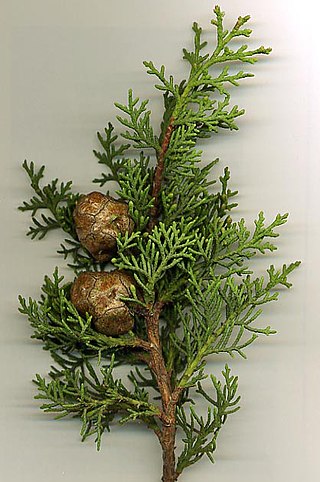
Cupressaceae or the cypress family is a family of conifers. The family includes 27–30 genera, which include the junipers and redwoods, with about 130–140 species in total. They are monoecious, subdioecious or (rarely) dioecious trees and shrubs up to 116 m (381 ft) tall. The bark of mature trees is commonly orange- to red-brown and of stringy texture, often flaking or peeling in vertical strips, but smooth, scaly or hard and square-cracked in some species. The family reached its peak of diversity during the mesozoic era.

Chamaecyparis obtusa is a species of cypress native to central Japan in East Asia, and widely cultivated in the temperate northern hemisphere for its high-quality timber and ornamental qualities, with many cultivars commercially available.

Chamaecyparis pisifera is a species of false cypress, native to central and southern Japan, on the islands of Honshū and Kyūshū.
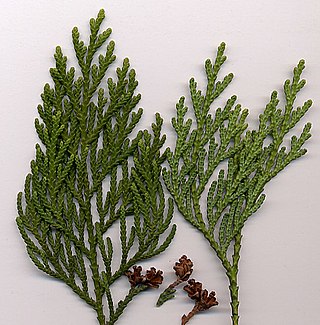
Thuja standishii is a species of thuja, an evergreen coniferous tree in the cypress family Cupressaceae. It is native to southern Japan, where it occurs on the islands of Honshū and Shikoku. It is a medium-sized tree, reaching 20–35 m tall and with a trunk up to 1 m diameter.

The Sister Mary Grace Burns Arboretum, on the campus of Georgian Court University, in Lakewood Township, New Jersey, United States, was once the landscaped park for the winter home of George Jay Gould, millionaire son of railroad tycoon Jay Gould.

The Larz Anderson Bonsai Collection at the Arnold Arboretum in Jamaica Plain, Massachusetts is one of the premier collections of bonsai in the United States and includes a Hinoki Cypress over 250 years old.

Chamaecyparis formosensis is a species of Chamaecyparis, endemic to Taiwan, where it grows in the central mountains at moderate to high altitudes of 1000–2900 m. It is threatened by habitat loss and over-cutting for its valuable timber.
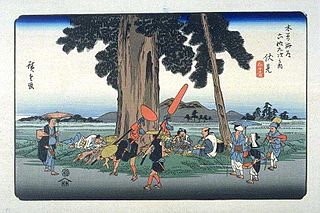
Fushimi-juku was the fiftieth of the sixty-nine stations of the Nakasendō connecting Edo with Kyoto in Edo period Japan. It is located in former Mino Province in what is now part of the town of Mitake, Kani District, Gifu Prefecture, Japan
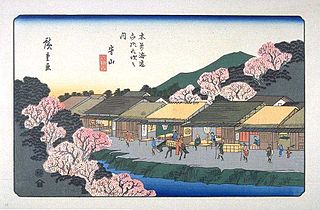
Moriyama-juku (守山宿) was the sixty-seventh of the sixty-nine stations of the Nakasendō highway connecting Edo with Kyoto in Edo period Japan. It was located in the present-day city of Moriyama, Shiga Prefecture, Japan.
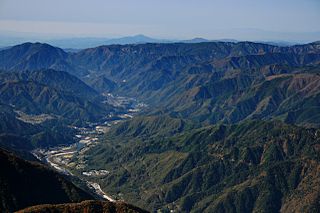
The Kiso Valley is a geographical area that centers on the valley of the upper portions of the Kiso River in the southwestern part of Nagano Prefecture in Japan. It is a v-shaped valley with length of approximately 60 km (36 mi) that follows the river as it flows from north by northwest to south by southwest into Gifu Prefecture.

Yakusugi (屋久杉) refers to "Japanese cedar" on the island of Yakushima, typically growing at altitudes 500 meters and higher. The term also extends to the lumber taken from the logging of these coniferous trees.

Thujaplicin is any of three isomeric tropolone-related natural products that have been isolated from the softwoods of the trees of Cupressaceae family. These compounds are known for their antibacterial, antifungal, and antioxidant properties. They were the first natural tropolones to be made synthetically.

Hinokitiol (β-thujaplicin) is a natural monoterpenoid found in the wood of trees in the family Cupressaceae. It is a tropolone derivative and one of the thujaplicins. Hinokitiol is used in oral and skin care products, and is a food additive used in Japan.

The flora of Japan comprises a large assemblage of plant species which can be found in Japan, such as sakura, katsura, momiji and azalea. There are many species which are endemic to Japan.

Naegi Castle was a Japanese castle that formed the administrative center of Naegi Domain, a feudal domain of the Tōyama clan, located in what is now part of the city of Nakatsugawa in Gifu Prefecture, Japan. It also referred to as the Misty Castle, Naegi Castle was also known as "Akakabe Castle", as its walls were not white like many Japanese castles, but made with a reddish colored clay. The ruins have been protected as a National Historic Site since 1981.

Shinrin-yoku, also known as forest bathing, is a practice or process of therapeutic relaxation where one spends time in a forest or natural atmosphere, focusing on sensory engagement to connect with nature.
















